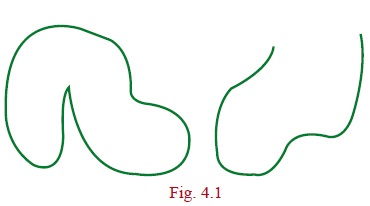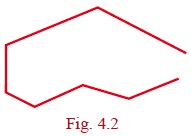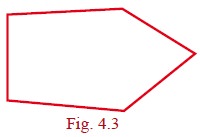Mathematics - Geometry: Introduction | 9th EM Mathematics : Geometry
Chapter: 9th EM Mathematics : Geometry
Geometry: Introduction
GEOMETRY
Introduction
In geometry, we study shapes. But what is there to study
in shapes, you may ask. Think first, what are all the things we do with shapes?
We draw shapes, we compare shapes, we measure
shapes. What do we measure in shapes?
Take some shapes like this:

In both of them, there is a curve forming the shape: one is a closed curve, enclosing a region,
and the other is an open curve. We can use a rope (or a thick string) and
measure the length of the open curve
and the length of the boundary of the region in the case of the closed curve.
Curves are tricky, aren’t they? It is so much
easier to measure length of straight
lines using the scale, isn’t it? Consider the two shapes below.

We are going to focus our attention for now only on
shapes made using straight lines, and only closed figures. As you will see,
there is plenty of interesting things to do already? Fig.4.2 shows an open
figure.


We not only want to draw such shapes, we want to
compare them, measure them and do much more.
For doing so, we want to describe
them. How would you describe these closed shapes? (See Fig 4.3) They are
all made of straight lines, all closed.
In science we learn that air has certain properties
– for instance, it occupies space. Water has the property that it takes the
shape of the vessel that contains it, flows from a height to down below.
Similarly, triangles, rectangles, circles, and all the shapes we draw, however
different they look, have properties that describe them uniquely. By the time you learn Geometry well, you can give shape
for everything on earth – indeed (Aadhaar card), not only on earth but
anywhere! But for now, have some patience. Just as we started with small
numbers and arithmetical operations on them in primary level classes and now
you know it is the same for all
numbers, similarly we will learn properties of very simple shapes now, and slowly but surely we will learn more and
when we are done, you will have techniques to describe any shape in 2 dimensions
(like what we draw on paper), or in 3 dimensions (like the solids we use in
life), or indeed, in any dimensions.
Why should we
bother to learn this? One very practical reason is that all science and engineering demands it. We cannot
design buildings, or even tables and chairs, or lay out the circuits inside our
mobile phones, without a mathematical understanding of shapes. Another
important reason is that geometry gives you a new way of looking at the world,
at everything in it. You begin to see that all objects, however complicated
they look, are made of very simple shapes. You learn to think not only like a
mathematician, but also learn to appreciate symmetry and order, as artists do.
Yes, geometry helps you become an artist too.